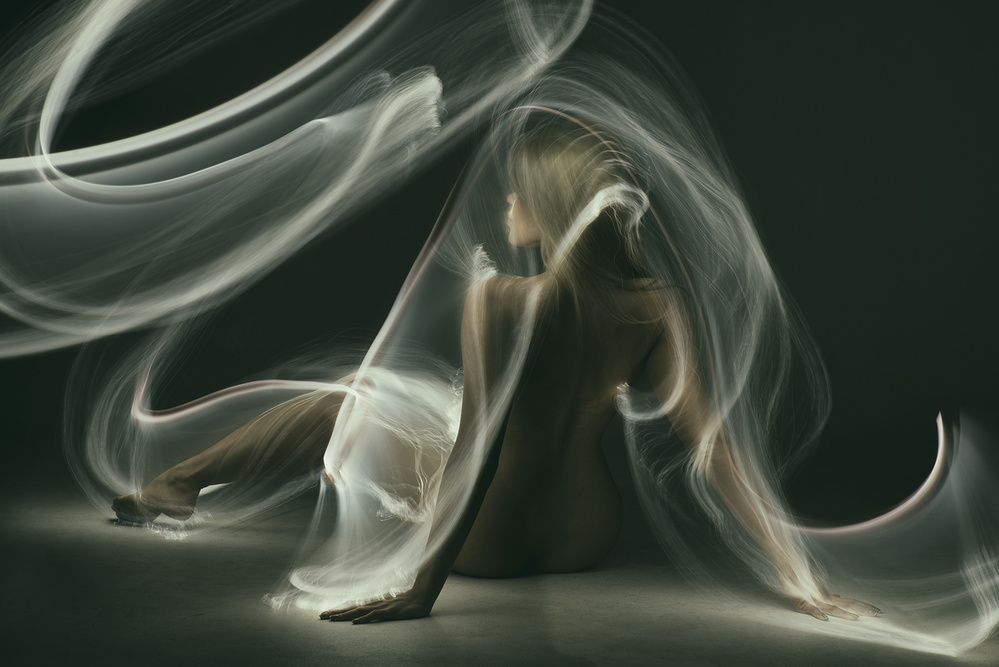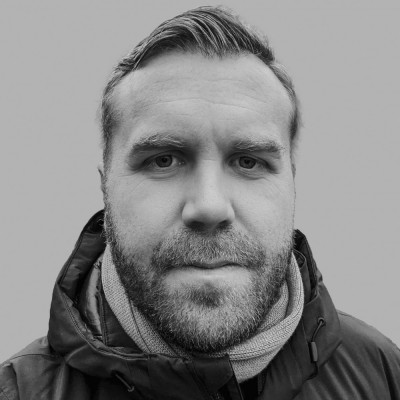SEARCH






|
|
|
|


by Editor Michel Romaggi in collaboration with the author Andris Apšenieks
Published the 21st of October. 2020
Andris Apšenieks excels in nude photography, moreover when he uses the light painting technique.
In this picture, the subject is emerging from the black background, drowned in volutes of light, which wraps her as in a very light vaporous cloth.
This photo offers a very strong aesthetic. The choice of very soft colours adds to this feeling.
The so well mastered light painting technique gives a very successful, even magic, result.
I was very excited to ask Andris to lift the veil on the secret of this artistic creation.

'REM_3288' by Andris Apshenieks
Why did you choose such a mathematical name, REM_3288, highly contrasting with the aesthetic fairy tale picture you made, Andris?
For my picture names, I'm just using the same file names as they come out from the camera ;-) By using a strong and specific picture name, authors can manipulate viewers: either by guiding them through picture content or playing with their minds. It is absolutely fine if we are speaking about documentary or genre photography where we have a story behind, where the picture name serves as a narrative.
But I'm shooting fine art pictures where I just try to show the human body in harmony in either a natural environment or using artificial light. I prefer that when viewers enjoy my work, they can tell me how they feel, what they see in the picture, or how they would name it. That's why I usually don't pay attention to picture names.
But, actually, the REM_3288 image already has a "normal" name, because I participated with this work in some photo contests (I have more than 160 awards from all continents yet) and in photo contests, authors always need to have real image names.
So, this particular work is called "Never back down" and it is part of the image series “Spirited Away”.
When and Why do you choose to use light painting in nude photography?
I like to work with the same models many times but when you shoot with the same ideas too often, it becomes boring. After a few years of shooting (I'm taking portraits and fine art nude works since 2012) I felt like falling into the usual trap for photographers: I'm not making progress any more but just shooting lovely ladies in lovely images in an ordinary way. I asked myself: 'How can I improve the results and make my work better?
To challenge myself in 2015, I started experimenting with light (long exposure, different non-studio light sources), focusing on creative photography and aiming to have interesting works already in the camera.
At the same time, I had the opportunity to learn from a doctor of physics how to understand light better. Thus, I realized there's a lot of space for improvements and I could turn out each photo shoot into a quest.
Photographers have a big power: using light allows them to show people in a better way, they can make interesting accents. I understood how poor my beginner's work was according to the light I used and was aiming to improve my skills.
Each photo shoot became as a learning lesson where I could learn something new and specifically when painting with light. I realized that I could create something difficult but extraordinary to remember.
But why painting with light and nudity?
Dresses quite often give wrong accents and make my life even more difficult. Some colour combinations will simply not work. The human body is beautiful as it is. I want to show the beauty of the human body and there are more than enough photographers who will shoot models in nice dresses.
Can you explain the processing to get such a result, can you tell us more about the light painting technique, about your photo equipment, about the settings?
As I create images painted with light, I need a model who has patience and who trusts me. That's why I rarely paint with light with new models. New models don't know how I work, they don't know how I put on poses. Meanwhile, I also don't know what will look great for this particular model. Models without experience don't have any idea how difficult it can turn out to work with light.
Regarding gear, you need a camera that supports manual mode, your favourite lens, a tripod, a trigger to launch the camera remotely, and some light source.
In the photo studio, I'm personally using a Nikon full-frame camera with an 85mm prime lens, YongNuo trigger, Manfrotto tripod. Light comes from flash lights - I have different ones. Mainly I'm using Fenix flash light (waterproof, adjustable light output, impact-resistant). My first flash light for light painting was Maglite which I bought as a tourist for a couple of euros a long time ago.
Regarding camera settings, it depends on your flash light and environment. You will need to start by setting the camera in Manual mode. I usually start with F8, exposure 3 seconds, and ISO 400 with my Fenix flash light. You need to understand the exposure triangle (ISO-shutter-aperture) – then you can adjust settings very easily after a couple of trials. White balance also must be changed accordingly as different flash lights have different light quality and power. When painting with light happens in an isolated studio environment, I try to have the exposure below 5 seconds because if you are shooting models, the longer the exposure is, the bigger the risk that the model will move and your image will not be sharp. Of course, you can combine it with studio lights but for myself, I found it as additional complexity.
Painting with light is simple:
- put a trigger on the camera,
- switch the camera to manual mode,
- adjust exposure,
- ask the model to stay in the same pose for some time,
- adjust the focus on the model and start painting with light...
As a light modifier, I used a lot of stuff from construction goods stores. The only limit is your imagination and now there are a lot of 'all ready to go gear' like Pixelstick if you already have a light picture in mind. You can use even a piece of glass or wrapping paper or a mobile phone. Just think about curves and body lines and how to light the model and go ahead.
You can get a lot of inspiration in classic paintings on how to light people, you can get a lot of inspiration on how to avoid chaos with light in modern paintings. And if you aim to have the acceptable results without Photoshop - the same as I do - remember to throw away hundreds or even thousands of images. For example, I have an image where I tried to draw wings on a model - it required more than 70 shots. Unfortunately, the curator team did not accept this image on 1x.com so I deleted it and it just remains in my portfolio on my home page and on my Instagram.
What was your photographic journey to get this far?
I'm a business process engineer in an international company, speaking in a language in which only IT guys understand and use various analytic tools.
Photography is how I see the beauty of the human body and how I see everything around me.
Photography allows me to meet so many interesting people and to get in such fantastic places!
A photo shoot is not just a camera shutter sound, it is also a feeling.
Sometimes, as an outcome, I'm lucky with good portrait work.
As I love difficulties and challenges I also shoot animals: cats, dogs, butterflies, deers, horses, and more.
I already tried shooting fire, shooting underwater, shooting models on the roof - high above the city. It does not matter where I take pictures, I just follow my inner feelings on how to show a particular model in the best way in an existing environment.
That's why I'm looking forward to people with the same passion as this is a difficult but wonderful journey!
Many thanks for this explanatory look on your excellent work, dear Andris!
 | Write |
 | Jacob Jovelou FOUNDER Great article! |
 | Filiberto Galli PRO Great article, inspiring matter. Thank you. |